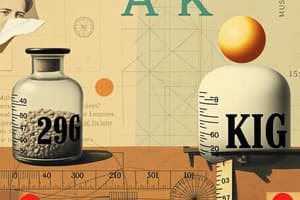Podcast
Questions and Answers
What is the purpose of placing a sample in a covered weighing bottle before weighing it?
What is the purpose of placing a sample in a covered weighing bottle before weighing it?
- To speed up the weighing process
- To prevent evaporation and absorption of moisture from the air (correct)
- To make the sample appear larger than its actual mass
- To allow for better visibility of the sample during weighing
Why should balances be placed on heavy surfaces when measuring an object's mass?
Why should balances be placed on heavy surfaces when measuring an object's mass?
- To keep the balance stable when not in use
- To make the balance more aesthetically pleasing
- To improve the accuracy of the measurements taken
- To reduce the impact of vibrations from the surrounding environment (correct)
Why is it recommended to weigh volatile liquid samples in a covered container?
Why is it recommended to weigh volatile liquid samples in a covered container?
- To speed up the evaporation process
- To allow for better visual inspection of the sample
- To reduce the weight of the sample
- To prevent sample loss due to evaporation (correct)
How can air currents affect the measurement of a sample's mass on a balance?
How can air currents affect the measurement of a sample's mass on a balance?
What should be done with samples dried in an oven to prevent reabsorption of moisture?
What should be done with samples dried in an oven to prevent reabsorption of moisture?
Why is it important to handle materials placed on a balance using tongs or laboratory tissues?
Why is it important to handle materials placed on a balance using tongs or laboratory tissues?
How is an object's mass measured using an electronic balance?
How is an object's mass measured using an electronic balance?
What does the current needed to produce a counterbalancing force in an electronic balance indicate?
What does the current needed to produce a counterbalancing force in an electronic balance indicate?
How is a sample's mass determined using a single-pan, unequal arm balance?
How is a sample's mass determined using a single-pan, unequal arm balance?
What is the purpose of placing a clean and dry container on the balance before weighing a material that is not moisture-sensitive?
What is the purpose of placing a clean and dry container on the balance before weighing a material that is not moisture-sensitive?
What happens when a sample is added to the balance pan in a single-pan, unequal arm balance?
What happens when a sample is added to the balance pan in a single-pan, unequal arm balance?
Why are selected standard weights removed in a single-pan, unequal arm balance when weighing a sample?
Why are selected standard weights removed in a single-pan, unequal arm balance when weighing a sample?
Flashcards are hidden until you start studying




